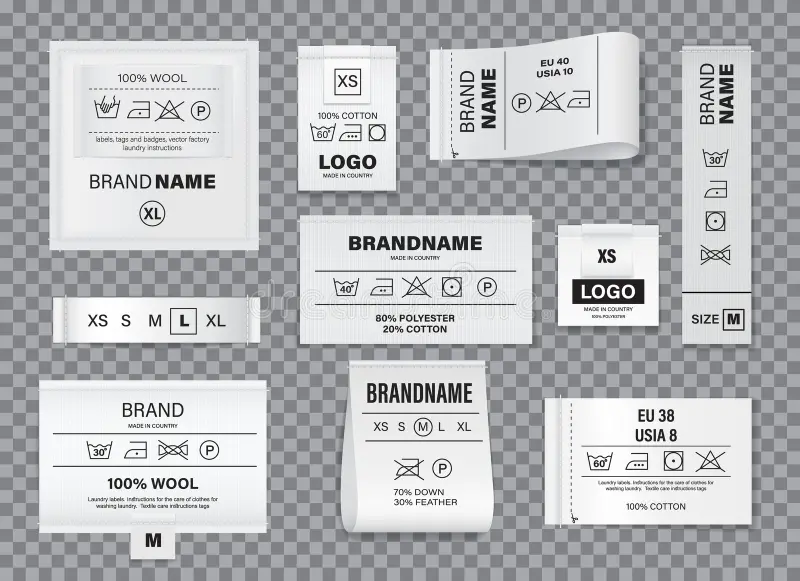Labels for Clothes and Laundry Labels: Small Tags, Big Importance
When you buy a new shirt, dress, or jacket, you probably notice a small piece of fabric stitched inside the garment — the clothing label. It might seem insignificant, but that tiny tag plays a huge role in branding, communication, and garment care. Labels for clothes and laundry labels are essential components of the fashion and textile industry, serving both practical and marketing purposes. Let’s explore what they are, why they matter, and how they contribute to both brands and consumers.
What Are Clothing Labels?
Clothing labels are small pieces of material attached to garments that provide vital information about the product. They can be made from woven fabric, satin, cotton, polyester, or paper, depending on the brand’s design and budget. These labels may contain the brand name, logo, size, material composition, origin, and washing instructions.
There are several types of clothing labels used in the apparel industry:
- Woven labels: Made by weaving threads into fabric, these labels are durable and give a premium, textured look. High-end fashion brands often prefer woven labels because they maintain their appearance over time.
- Printed labels: These are printed directly onto satin or cotton materials using ink. They are cost-effective and suitable for casual wear or mass production.
- Heat transfer labels: These labels are printed onto garments using heat and pressure, leaving no visible fabric tag. They’re popular in sportswear and activewear for comfort.
- Leather and PVC labels: These add a stylish, durable touch often seen on jeans, jackets, and outdoor apparel.
Each type of label serves a unique function, balancing aesthetics, comfort, and branding.
The Importance of Clothing Labels
A clothing label does far more than display a brand name. It’s a communication bridge between the manufacturer and the customer. Here are the main reasons labels are so important:
- Brand Identity
Labels are a key part of a brand’s identity. The logo, font, and color scheme tell a story about the brand’s personality. A well-designed woven label instantly signals quality and authenticity, making a garment more recognizable in the market. - Consumer Information
Clothing labels provide essential details that help consumers make informed decisions — such as size, fabric type, and country of origin. This information builds trust and transparency. - Legal Requirements
Many countries have regulations that require clothing manufacturers to include information like fiber content, washing symbols, and origin. Non-compliance can result in legal issues or product recalls. - Product Tracking and Inventory
Labels often include barcodes or QR codes that help retailers and manufacturers track inventory efficiently. Digital labeling systems are becoming increasingly common in modern textile operations. - Customer Loyalty
When customers love a garment, they often check the label to find the brand name for future purchases. That small tag can turn one-time buyers into loyal customers.
Laundry Labels: Care and Maintenance Made Simple
Alongside brand labels, laundry labels — also known as care labels — are another vital part of clothing production. These labels tell you how to wash, dry, iron, and store your garments to maintain their quality.
A typical laundry label includes a combination of symbols and text that describe proper care methods. For instance:
- A tub symbol indicates machine washing, with numbers showing the recommended water temperature.
- A triangle relates to bleaching instructions.
- A square with a circle represents tumble drying.
- An iron icon tells you if and how you can iron the fabric.
- A circle stands for dry cleaning.
These symbols follow international standards, such as those set by ISO (International Organization for Standardization) or regional systems like Ginetex in Europe.
Ignoring these instructions can damage clothes — colors might fade, fabrics could shrink, or stitching may loosen. Therefore, laundry labels protect both the garment and the consumer’s investment.
Materials and Sustainability in Labels
In recent years, sustainability has become a major focus in the fashion industry, and labels are part of that shift. Eco-conscious brands are now using organic cotton, recycled polyester, bamboo fibers, or biodegradable materials for their labels. Some even use digital QR labels that link to online product information, reducing the need for multiple tags.
Sustainable labeling not only reduces environmental impact but also enhances a brand’s eco-friendly image. Consumers increasingly appreciate when brands show care for the planet in every detail — even on something as small as a tag.
How Labels Influence Consumer Perception
The design, texture, and placement of a clothing label can subtly influence how consumers perceive the overall product. A soft satin label feels luxurious and comfortable against the skin, while a coarse woven label might feel more rugged and suited to denim or workwear. Every detail reinforces the garment’s intended message — elegance, comfort, or durability.
Moreover, an aesthetic label design enhances the overall presentation of a product. It reflects a brand’s attention to detail, signaling quality craftsmanship and professionalism.
Conclusion
Clothing labels and laundry labels may be small, but they play a massive role in the fashion industry. They communicate identity, provide essential care information, ensure legal compliance, and strengthen brand recognition. From premium woven tags to eco-friendly digital QR codes, the humble label continues to evolve with technology and sustainability trends.
In essence, labels for clothes are not just tags — they are storytellers, guides, and guardians of quality. They connect the consumer to the brand, the product to its maker, and style to sustainability. Next time you buy a piece of clothing, take a moment to look at its label — it carries more meaning than you might think.
Would you like me to make this article more SEO-optimized (for keywords like “custom clothing labels” or “laundry care labels”) so it ranks better on Google?

